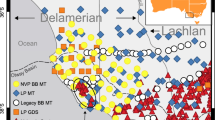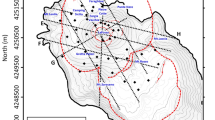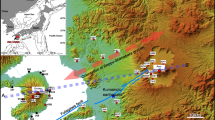Abstract
Three prominent volcanoes that form part of the Cascade mountain range in Washington State (USA)—Mounts St Helens, Adams and Rainier—are located on the margins of a mid-crustal zone of high electrical conductivity1,2,3,4,5. Interconnected melt can increase the bulk conductivity of the region containing the melt6,7, which leads us to propose that the anomalous conductivity in this region is due to partial melt associated with the volcanism. Here we test this hypothesis by using magnetotelluric data recorded at a network of 85 locations in the area of the high-conductivity anomaly. Our data reveal that a localized zone of high conductivity beneath this volcano extends downwards to join the mid-crustal conductor. As our measurements were made during the recent period of lava extrusion at Mount St Helens, we infer that the conductivity anomaly associated with the localized zone, and by extension with the mid-crustal conductor, is caused by the presence of partial melt. Our interpretation is consistent with the crustal origin of silicic magmas erupting from Mount St Helens8, and explains the distribution of seismicity observed at the time of the catastrophic eruption in 1980 (refs 910, 10).
This is a preview of subscription content, access via your institution
Access options
Subscribe to this journal
Receive 12 print issues and online access
$259.00 per year
only $21.58 per issue
Buy this article
- Purchase on Springer Link
- Instant access to full article PDF
Prices may be subject to local taxes which are calculated during checkout




Similar content being viewed by others
Change history
30 October 2009
In the version of this Letter originally published, in Fig. 2 the elongated closed contour line should have been labelled +4. This error has been corrected in the HTML and PDF versions.
References
Stanley, W. D. Tectonic study of the Cascade Range and Columbia Plateau in Washington based on magnetotelluric soundings. J. Geophys. Res. 89, 4447–4460 (1983).
Stanley, W. D., Finn, C. A. & Plesha, J. L. Tectonics and conductivity structures in the southern Washington Cascades. J. Geophys. Res. 92, 10179–10193 (1987).
Stanley, W. D., Mooney, W. D. & Fuis, G. S. Deep crustal structure of the Cascade Range and surrounding regions from seismic refraction and magnetotelluric data. J. Geophys. Res. 95, 19419–19438 (1990).
Stanley, W. D., Johnson, S. Y., Qamar, A. I., Weaver, C. S. & Williams, J. M. Tectonics and seismicity of the Southern Washington Cascade Range. Bull. Seismol. Soc. Am. 86, 1–18 (1996).
Egbert, G. D. & Booker, J. R. Imaging crustal structure in south western Washington with small magnetometer arrays. J. Geophys. Res. 98, 15967–15986 (1993).
Gaillard, F. & Marziano, G. I. Electrical conductivity of magma in the course of crystallization controlled by their residual liquid composition. J. Geophys. Res. 110, B06204 (2005).
ten Grotenhuis, S. M., Drury, M. R., Spiers, C. J. & Peach, C. J. Melt distribution in olivine rocks based on electrical conductivity measurements. J. Geophys. Res. 110, B12201 (2005).
Gardner, J. E., Carey, S., Sigurdsson, H. & Rutherford, M. J. Influence of magma composition on the eruptive activity of Mount St Helens, Washington. Geology 23, 523–526 (1995).
Scandone, R. & Malone, S. D. Magma supply, magma discharge and readjustment of the feeding system of Mount St Helens during 1980. J. Volcanol. Geotherm. Res 23, 239–262 (1985).
Musumeci, C., Malone, S. D. & Gresta, E. Magma system recharge of Mount St Helens (USA) from precise relative hypocenter location of microearthquakes. J. Geophys. Res. 107, 2264 (2002).
Patro, P. K. & Egbert, G. D. Regional conductivity structure of Cascadia: Preliminary results from 3D inversion of USArray transportable array magnetotelluric data. Geophys. Res. Lett. 35, L20311 (2008).
Caldwell, T. G., Bibby, H. M. & Brown, C. The magnetotelluric phase tensor. Geophys. J. Int. 158, 457–469 (2004).
Parkinson, W. D. The influence of continents and oceans on geomagnetic variations. Geophys. J. R. Astron. Soc. 6, 441–449 (1962).
Wannamaker, P. E. et al. Fluid generation and pathways beneath an active compressional orogen, the New Zealand Southern Alps, inferred from magnetotelluric data. J. Geophys. Res. 107, 2117 (2002).
Booker, J. R., Favetto, A. & Pomposiello, M. C. Low electrical resistivity associated with plunging of the Nazca flat slab beneath Argentina. Nature 429, 399–403 (2004).
Rodi, W. & Mackie, R. Non-linear conjugate gradient algorithm for 2D magnetotelluric inversion. Geophysics 66, 174–178 (2001).
Siripunvaraporn, W., Egbert, G., Lenbury, Y. & Uyeshima, M. Three-dimensional magnetotelluric: Data space method. Phys. Earth Planet. Inter. 150, 3–14 (2005).
Mackie, R. L., Smith, J. T. & Madden, T. R. Three-dimensional electromagnetic modelling using finite difference equations: The magnetotelluric example. Radio Sci. 29, 923–935 (1994).
Lees, J. M. & Crosson, R. S. Tomographic inversion for three-dimensional velocity structure at Mount St Helens using earthquake data. J. Geophys. Res. 94, 5716–5728 (1989).
Lees, J. M. The magma system of Mount St Helens: Non-linear high resolution P-wave tomography. J. Volcanol. Geotherm. Res. 53, 103–116 (1992).
Miller, K. C. et al. Crustal structure along the west flank of the Cascades, western Washington. J. Geophys. Res. 102, 17857–17873 (1997).
Heliker, C. Inclusions in Mount St Helens dacite erupted from 1980 through 1983. J. Volcanol. Geotherm. Res. 66, 115–135 (1995).
Bachmann, O. & Bergantz, G. The magma reservoirs that feed supereruptions. Elements 4, 17–21 (2008).
Pallister, J. S., Hoblitt, R. P., Crandell, D. R. & Mullineaux, D. R. Mount St Helens a decade after the 1980 eruptions: Magmatic models, chemical cycles, and a revised hazards assessment. Bull. Volcanol. 54, 126–146 (1992).
Smith, D. R. & Leeman, W. P. Petrogenesis of Mount St Helens dacitic magmas. J. Geophys. Res. 92, 10313–10334 (1987).
Defant, M. F. & Drummond, M. S. Mount St Helens: Potential example of the partial melting of the subducted lithosphere in a volcanic arc. Geology 21, 547–550 (1993).
Leeman, W. P., Smith, D. R., Hildreth, W., Palacz, Z. & Rogers, N. Compositional diversity of late Cenozoic basalts in a transect across the Southern Washington Cascades: Implications for subduction zone magmatism. J. Geophys. Res. 95, 19561–19582 (1990).
Blackwell, D. D., Steele, J. L., Kelley, S. & Korosec, M. A. Heat flow in the state of Washington and thermal conditions in the cascade range. J. Geophys. Res. 95, 19495–19516 (1990).
Wilson, C. J. N. et al. Volcanic and structural evolution of Taupo Volcanic Zone, New Zealand: A review. J. Volcanol. Geotherm. Res. 68, 1–28 (1995).
Heise, W. et al. Melt distribution beneath a young continental rift: The Taupo Volcanic Zone, New Zealand. Geophys. Res. Lett. 34, L14313 (2007).
Acknowledgements
We would like to thank W. Siripunvarporn for the use of his 3D inverse modelling code WSINV3DMT. B. Schaefer is thanked for the many discussions and support he lent to the completion of the work. The Yakama Nation, Weyerhaeuser, Olympic Resource Management and the US Forest Service are thanked for allowing us access to their land during the course of data collection. The logistical support of L. Mastin (Cascades Volcano Observatory—USGS), E. Rose and G. Barker is gratefully appreciated. We would like to thank E. Castleberry, J. Ellison, A. Fisher, T. Fisher, A. Green, J. Hill, Q. Jordan-Knox, V. Maris, M. McKenna, M. McLean, N. Olivier and L. Wan for help with data collection during the two field campaigns. H. Brasse and G. Jiracek provided reviews of the manuscript.
Author information
Authors and Affiliations
Contributions
G.J.H. designed the experiment. G.J.H., T.G.C. and D.G.C. wrote the paper. G.J.H. and W.H. reduced the observed time series. G.J.H., T.G.C., W.H. and H.M.B. carried out the modelling. G.J.H., M.K.B., D.G.C., W.H. and R.A.F.C. carried out the field campaign. All authors contributed to the interpretation and manuscript editing.
Corresponding author
Supplementary information
Supplementary Information
Supplementary Information (PDF 4934 kb)
Rights and permissions
About this article
Cite this article
Hill, G., Caldwell, T., Heise, W. et al. Distribution of melt beneath Mount St Helens and Mount Adams inferred from magnetotelluric data. Nature Geosci 2, 785–789 (2009). https://doi.org/10.1038/ngeo661
Received:
Accepted:
Published:
Issue Date:
DOI: https://doi.org/10.1038/ngeo661
This article is cited by
-
The Magma Emplacement of a Composite Volcanic-Intrusive System and Its Mineralization
Surveys in Geophysics (2024)
-
Constraints on magma storage conditions based on geodetic volume change and erupted magma volume and application to the 2011 and 2018 eruptions at Kirishima Shinmoe-dake volcano, Japan
Earth, Planets and Space (2023)
-
Volcanic monitoring of the 2021 La Palma eruption using long-period magnetotelluric data
Scientific Reports (2023)
-
Development of a volcanic risk management system at Mount St. Helens—1980 to present
Bulletin of Volcanology (2023)
-
A broadband magnetotelluric survey for Mt. Meakandake volcano with special attention to the unrest during 2016–2017
Earth, Planets and Space (2022)



